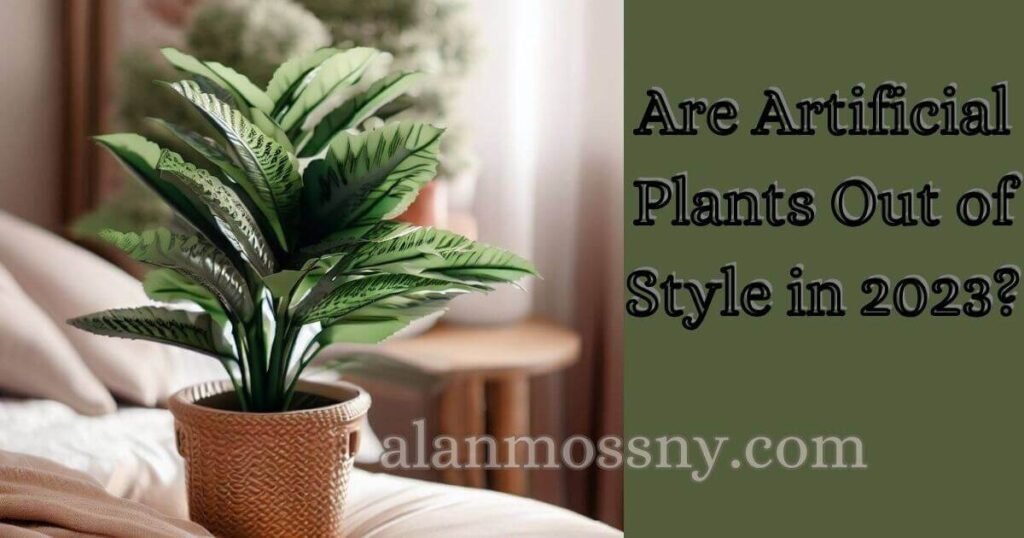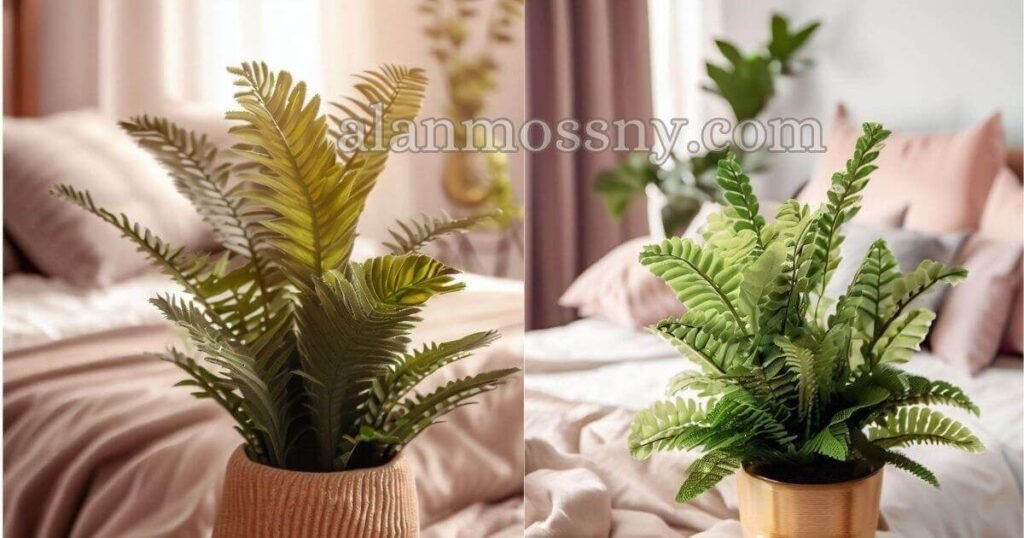Are Artificial Plants Out of Style in 2023?
In recent times, interior design has seen many changes. A notable trend is the growing use of artificial plants for decoration. Both homeowners and businesses are finding these plants to be an excellent choice. As faux flora has improved in quality and realism, more people are turning to them for low-maintenance, allergy-friendly, and versatile decor. In this article you will explore the current state of artificial plants, are artificial plants out of style in 2023, weighing their pros and cons, and examining their place in today’s stylish spaces.

The Pros and Cons of Artificial Plants
The Advantages of Artificial Plants
Low maintenance: Artificial plants have low maintenance requirements, which is one of their significant advantages. Low maintenance and does not require water, fertilizer, or pruning. They are perfect for those who are not good at gardening or lead busy lives.
Allergy-friendly: Allergy sufferers can enjoy the beauty of plants without the sneezing, itching, and watery eyes that real plants can sometimes cause. Artificial plants are hypoallergenic, providing a safe alternative for those sensitive to pollen or mold.
Durability and longevity: Artificial plants can last for years, even decades, with proper care. They don’t wilt, fade, or die, and can withstand extreme temperatures and conditions that would harm real plants.
Consistent appearance: Faux flora maintains its appearance year-round, ensuring that your decor always looks fresh and vibrant, regardless of the season or weather.
Versatility in design: Artificial plants come in many colors, shapes, and sizes, offering unlimited design options. You can easily move, reuse, or swap them to keep your space looking modern and fashionable.
Safe for pets and children: Many real plants are toxic to pets and children, but artificial plants pose no such risk. They provide a worry-free way to add greenery to your home.
The Disadvantages of Artificial Plants
Environmental concerns: Artificial plant production frequently utilizes non-renewable resources, such as petroleum-based plastics. Moreover, these items do not decompose naturally, leading to environmental contamination and littering when disposed of.
Lack of natural benefits: Faux flora doesn’t offer the same air-purifying, oxygen-producing, or humidity-regulating benefits as real plants.
Aesthetic limitations: While some artificial plants are incredibly realistic, they still lack the organic beauty and natural variation found in real plants.
Possible health concerns: Some low-quality fake plants can give off harmful chemicals called VOCs, which might cause breathing problems and other health concerns for certain people.
Quality variations between products: The market for artificial plants is vast, and the quality can vary significantly between products. It’s essential to carefully research and select high-quality options to ensure they look realistic and last as long as possible.
Comparing Real and Artificial Plants
Maintenance and care
Real plants require regular watering, fertilizing, and pruning, whereas artificial plants need little to no maintenance. However, they do require occasional dusting and cleaning to maintain their appearance.
Cost analysis
While artificial plants may have a higher initial cost, their longevity and low maintenance needs can make them a more cost-effective option in the long run. Real plants need regular replacement and ongoing care, which can add up over time.
Environmental impact
Real plants offer many environmental benefits, while artificial plants can have negative impacts due to their production and disposal. However, eco-friendly alternatives are becoming increasingly available, and responsible consumption can help mitigate these concerns.
Health benefits and drawbacks
Real plants can improve air quality and provide mental health benefits, while artificial plants pose minimal health risks.
Aesthetics and design flexibility
While real plants offer organic beauty and natural variation, artificial plants provide consistent appearance and design versatility. The choice between the two depends on personal preferences and the desired aesthetic for a space.
Advances in Artificial Plant Technology
Higher-quality materials
Nowadays, artificial plants are crafted using advanced materials, such as polyethylene, which closely mimic the appearance and texture of genuine plants.
Artisanal and custom designs
Artisans and designers are creating unique, handcrafted artificial plants to meet the growing demand for realistic and stylish faux flora.
Eco-friendly alternatives
Companies are increasingly producing environmentally friendly artificial plants made from sustainable materials like recycled plastics and biodegradable components.
Innovations in manufacturing
New manufacturing techniques and technologies have led to more realistic and lifelike artificial plants, enhancing their appeal as a design element.
Integration of smart technology
App-controlled lighting: Some artificial plants now feature integrated lighting that can be controlled via smartphone apps, allowing for customizable ambiance and mood-setting options.
Interactive design elements: Interactive elements, such as touch-sensitive leaves or motion-activated sound effects, are being incorporated into artificial plants for an engaging, immersive experience.

The Impact of Social Media and Influencers on Artificial Plant Trends
Popularizing faux flora: Social media platforms and influencers have played a significant role in popularizing artificial plants, showcasing their beauty and versatility in various design settings.
Creating demand for unique and custom designs: Social media has fueled the desire for one-of-a-kind and personalized artificial plants, leading to increased demand for artisanal and custom creations.
Driving improvements in quality and realism: As artificial plants gain popularity on social media, companies are compelled to improve the quality and realism of their products to meet consumer expectations.
Encouraging responsible consumption: Social media influencers and environmentally conscious consumers are advocating for responsible consumption, driving companies to produce more eco-friendly artificial plants.
Factors to Consider When Choosing Artificial Plants:
Placement and purpose: Consider where the artificial plant will be placed and its intended purpose. Outdoor plants require UV-resistant materials, while indoor plants may need different sizes and shapes to fit specific spaces.
Personal preferences: Choose artificial plants that align with your personal style and aesthetic preferences.
Budget and long-term investment: Consider the initial cost of the artificial plant as well as its longevity, maintenance, and replacement costs.
Material quality and safety: Choose fake plants made from top-quality, harmless materials that are safe for kids, pets, and people with allergies or sensitivities.
Coordination with existing design elements: Choose artificial plants that complement and enhance your existing decor and design scheme.
Expert Tips for Styling Artificial Plants
Mixing with natural plants
Combine artificial and natural plants in your space to create a more dynamic and beautiful design.
Focusing on quality
Invest in high-quality artificial plants for a more realistic and aesthetically pleasing result.
Proper care and cleaning
Regularly clean and dust your artificial plants to maintain their appearance and ensure they look their best.
Creative placement ideas
Experiment with unique and unexpected placement ideas, such as hanging plants from the ceiling or incorporating them into wall art.
Seasonal decorating with faux flora
Holiday-inspired arrangements: Use artificial plants to create festive holiday displays like Christmas, Easter, or Halloween.
Rotating styles for fresh looks: Rotate your artificial plants regularly to keep your space looking fresh and updated.
Top Brands and Retailers for Artificial Plants: Finding the Best Quality and Value
Top-rated brands
Research and select brands known for producing high-quality, realistic artificial plants, such as Nearly Natural, Silk Plants Direct, and Commercial Silk.
Affordable options
Look for affordable, high-quality options, such as IKEA or HomeGoods.
Specialty retailers
Consider specialty retailers like Terrain, West Elm, or Crate and Barrel for unique and stylish artificial plant options.
Online shopping tips
Reading reviews and researching products: Before purchasing artificial plants online, read customer reviews and thoroughly research to ensure you get a high-quality product.
Ensuring secure transactions and returns: Shop on reputable websites with secure payment options and clear return policies to protect your purchase.
DIY Projects and Creative Uses for Artificial Plants
Custom arrangements: Create custom arrangements with artificial plants, mixing and matching various stems, leaves, and flowers to suit your style.
Crafting with faux flowers: Use artificial flowers in crafting projects, such as wreaths, garlands, or hair accessories.
Upcycling and repurposing artificial plants: Give old or damaged artificial plants new life by upcycling or repurposing them into new decorative items or functional pieces.
Incorporating faux plants into functional items: Integrate artificial plants into functional items, like storage containers or furniture, to add a touch of greenery and style.

The Role of Artificial Plants in Commercial and Public Spaces
Retail environments
Artificial plants are often used in retail settings to create inviting, low-maintenance displays that enhance the shopping experience.
Restaurants and cafes
Faux flora is commonly used in restaurants and cafes to add ambiance and style without the need for ongoing maintenance.
Office spaces
Artificial plants can brighten up office spaces and create a more pleasant working environment without the need for regular care.
Hospitality industry
Hotels and other hospitality venues frequently use artificial plants to create inviting, stylish, and low-maintenance spaces for guests.
Public spaces and installations
Public spaces like airports, parks, and museums often incorporate artificial plants into their designs to provide visual interest and reduce maintenance requirements.
Exploring Cultural Perspectives on Artificial Plants
The role of artificial plants in different cultures
In certain cultures, fake plants represent wealth and good fortune, while in others, they are seen as easy choices instead of real plants.
Traditional uses of faux flora in ceremonies and events
Artificial plants have been used in various cultural events and ceremonies, such as weddings, religious celebrations, and funerals, where their durability and consistent appearance are valued.
Influences of cultural trends on artificial plant design
Design trends from different cultures, like the Japanese art of ikebana or the Mexican tradition of papel picado, can influence the styles and designs of artificial plants.
The Future of Artificial Plants: Industry Insights and Predictions
Technological advancements and their impact on faux flora
As technology continues to advance, artificial plants will likely become even more realistic, customizable, and eco-friendly.
The role of sustainability in the artificial plant industry
As environmental concerns continue to grow, the artificial plant industry will likely focus more on sustainable materials and production methods.
Emerging trends in interior design and their influence on artificial plants
New interior design trends, such as biophilic design, will shape the future of artificial plants, driving demand for new styles, colors, and forms.
Conclusion Of Are Artificial Plants Out of Style
The ongoing debate on artificial plants is influenced by personal choice and individual preferences. As technology and design continue to evolve, faux flora will likely become even more realistic and eco-friendly, making them an attractive option for many people. Artificial plants should be used in interior design after considering upkeep, beauty, environmental effect, and personal taste. As we move forward, the role of artificial plants in modern spaces will continue to change and adapt, providing new opportunities for stylish and low-maintenance decor. Check out our home decor social platform.
Frequently Asked Questions For Are Artificial Plants Out of Style
Are artificial plants tacky?
No, modern artificial plants can be very realistic and stylish, making them a popular choice for many interior design schemes.
How can I make artificial plants look more realistic?
Invest in high-quality artificial plants and mix them with real plants to create a more authentic appearance.
What are the best materials for artificial plants?
Polyethylene, silk, and other high-quality materials are best for creating realistic and durable artificial plants.
Can artificial plants be used outdoors?
Yes, artificial plants can be used outdoors, but make sure to choose options specifically designed for outdoor use, which are typically made from UV-resistant materials to prevent fading and damage from sunlight.
How do I clean and maintain artificial plants?
To clean artificial plants, gently dust them with a soft cloth or feather duster. For deeper cleaning, you can use a damp cloth or even a mild soap solution. Be sure to let the plant’s air dry completely before displaying them again.
